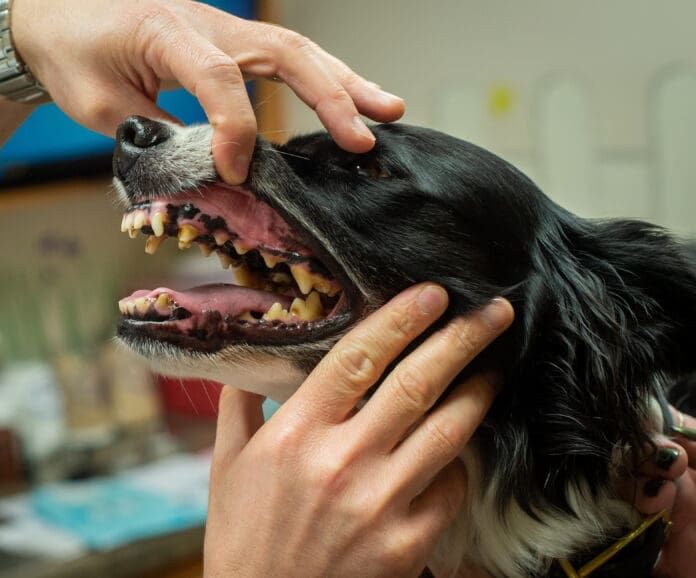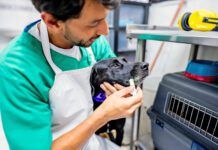Most of us have or know a dog who has bad breath. Your face scrunches in disgust when they pant near your face or you are snuggling close on the couch. Veterinarians and veterinary technicians label that smell as “sewer mouth.” It is one of the signs of periodontal disease in dogs.
Periodontal disease is the inflammation and infection of the periodontium. The periodontium are the structures that support and surround the teeth. This includes the gingiva, cementum, periodontal ligament, and alveolar bone. Let’s examine the role of each structure in protecting and maintaining your dog’s oral health.
Each tooth has two parts—the crown and one or more roots. The crown is the part of the tooth you can see. Its role is to tear, chop, and grind food. The crown extends to just below the gumline. The roots anchor the tooth in the jaw and provide a blood and nerve supply to each tooth.
Each tooth root sits in a socket in the jaw. The socket is made of alveolar bone lined with a protective layer called cementum. The socket surrounds and supports each root. The root is attached to the cementum and alveolar bone by a periodontal ligament. Gingiva (also known as the gums) is the pink or pigmented fleshy tissue that covers the alveolar bone and the first part of the crown.
Infection and inflammation of these supporting structures leads to destruction of cementum and alveolar bone, loosening and destruction of the periodontal ligament, and gingival recession. Without the support of these structures, teeth become diseased, loose, and fall out.
What Causes Periodontal Disease in Dogs?
Periodontal disease begins with the accumulation of plaque on the crown of each tooth—both the part you can see and the part just below the gumline. Plaque is a combination of food particles, proteins and minerals in saliva, and bacteria that normally exist in the mouth. Think about that fuzzy feeling you get on the surface of your teeth if you haven’t brushed them in over a day—that’s plaque.
Plaque is initially soft and can be easily broken down and removed if the teeth are brushed. But left undisturbed, plaque continues to accumulate layer by layer on the teeth. Over time, minerals in saliva harden plaque and create calculus. Calculus is the hard, brown layer that you might see on your dog’s teeth.
Although calculus on the crown of the tooth looks awful, it’s the plaque and calculus under the gumline that starts the process of periodontal disease. Think about the last time you ate popcorn. Inevitably, the thin skin that covers a popcorn kernel gets stuck in your teeth, prompting you to perform an impromptu flossing. That kernel skin is actually getting stuck in the thin space between the crown of your tooth and the gingiva.
Plaque and calculus that accumulates in that thin space induces an inflammatory response in your dog’s mouth. Inflammation causes the gingiva to become red, irritated, and painful. This is gingivitis and is the first stage of periodontal disease.
Irritated and inflamed gingiva begins to break down and separate from the tooth and alveolar bone. This creates a space known as a periodontal pocket. Plaque and calculus move into this pocket, creating more inflammation. Destruction of alveolar bone and cementum begins, exposing each root under the gumline. The gums may bleed easily when touched. This is the second stage of periodontal disease.
As the periodontal pocket expands and fills with more plaque and calculus, more alveolar bone and cementum are destroyed. The strength of the periodontal ligament holding the tooth root in the socket is compromised and the tooth becomes loose. This is the third stage of periodontal disease.
The fourth and final stage of periodontal disease is characterized by greater than 50% alveolar bone loss around the roots. The tooth can now be easily moved in all directions within the socket.
All dogs are at risk for developing periodontal disease. Small and toy breed dogs are particularly predisposed to periodontal disease. Periodontal disease is more prevalent in dogs that have diabetes mellitus or hyperadrenocorticism (Cushing’s disease). Dogs with a malocclusion (misaligned teeth) or crowded teeth in a small mouth are particularly at risk for developing periodontal disease.
Treating Periodontal Disease
Early periodontal disease (stages 1 and 2) in dogs may be treated with a professional dental cleaning under general anesthesia. Removing the plaque and calculus that has accumulated under the gumline is essential to treating periodontal disease—the only way to safely accomplish this is when your dog is anesthetized. See the article “Dog Teeth Cleaning” for more information.
Treating moderate to advanced periodontal disease (stages 3 and 4) requires more advanced techniques to save the teeth. These advanced techniques include open root scaling and planing, gingival curettage, and installation of bone grafts and protective membranes. A board-certified veterinary dentist is the most qualified professional to complete these techniques.
Teeth affected by periodontal disease that cannot be saved will need to be extracted. Tooth extractions can be done by most general practitioners. Teeth that have become brittle, abscessed, or ankylosed in the socket by scar tissue may need to be extracted by a veterinary dentist.
Preventing Periodontal Disease in Dogs
The best way to prevent periodontal disease in dogs is with proper at-home dental care and annual comprehensive oral health assessment and treatment (also known as a dental cleaning or dental prophylaxis) performed by your dog’s veterinarian.
Brushing your dog’s teeth every day disrupts plaque as it forms on the teeth and prevents the formation of calculus. See the article “At-home Dental Care for Dogs” for more information on how to brush your dog’s teeth and promote good oral health at home.
Your dog should undergo a comprehensive oral health assessment and treatment once a year. This is a dental cleaning, visual examination of the teeth, probing of gingival pockets, and radiographic assessment of the tooth roots and alveolar bone. Gingivitis can be treated and reversed during this procedure before it progresses to more advanced stages of periodontal disease.
With proper at-home oral care and annual oral exams by your veterinarian, your dog’s oral health and life span can be improved. And that’s good news for us dog lovers that want to have as much time as possible with our canine best friends!






